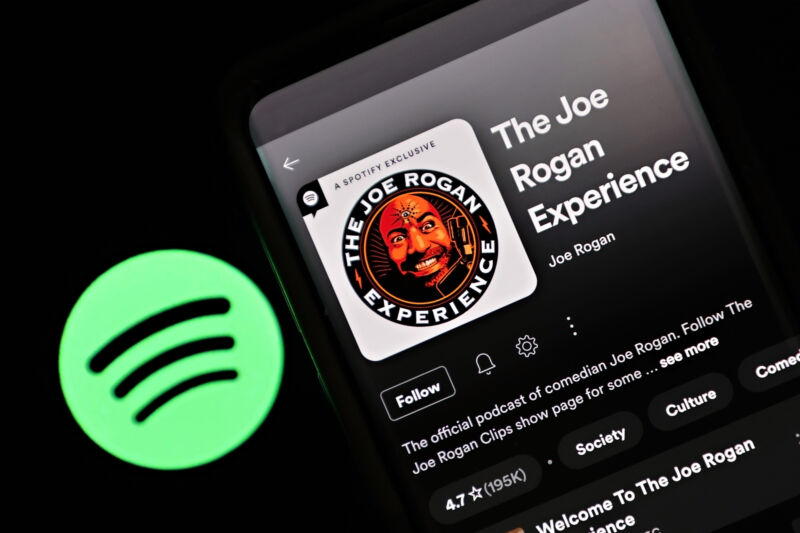
Spotify probably didn’t realize it, but it ceased being a tech company a few years ago.
It was excelling at all the tech startup things—attracting users and losing money—but like most businesses, it eventually wanted to make a profit. The company was having a tough time doing that simply by streaming music, which proved to be expensive since the labels demanded a hefty fee to access their catalogs. Without another product to sell alongside music, Spotify was hemorrhaging money.
So the company started looking afield, searching for a product that would complement its existing music offerings. It found one in podcasts.
Spotify had finally found a path to profitability. Podcasts brought in big ad spends, and they could be made for less than it cost to license music catalogs. Plus, podcasts kept users coming back. After all, the big streaming services all offer most of the music people listen to, which makes switching easier. But exclusive podcasts aren’t available anywhere else. They lock fans in.
In February 2019, Spotify bought podcast production company Gimlet, which had a sizable stable of shows. Then it snapped up a couple more companies before making a high-profile acquisition of The Ringer, a podcast network founded by former ESPN sportswriter Bill Simmons. In May 2020, Spotify bought an exclusive license to past and future episodes of Joe Rogan’s show.
But in the process, Spotify had changed. Now the future of the company depended not on a better music-streaming widget but rather on the podcasts it produced and the ads it sold around them. Music existed to broaden the offering.
Other companies may not repeat Spotify’s transformation from platform to media company. It might be a one-off, a necessity given the vagaries of the music-streaming industry. But it could just as likely be a cautionary tale about what happens to platforms when they run out of room to grow.
Platforms’ advantages
Today, tech platforms generally have several advantages over media companies. While both use the Internet to reach potentially billions of users, platforms have an edge because they serve both consumers and producers. They handle the underlying software and infrastructure, and other entities make the content that makes the platform valuable.
On platforms, users and customers are sometimes different. Facebook and Twitter, for example, famously sell their users’ data to advertisers, who are the customers. Spotify has muddied the waters a bit, selling subscriptions to users while also using listening data to sell companies ad space in podcasts. (Spotify also offers a free tier that plays more ads.)
In addition, platforms hold a regulatory edge over media companies. Section 230 of the Communications Decency Act gives platforms broad immunity for what gets published using their tools. That’s not the case for publishing companies, which are generally responsible for the content they produce. Platforms also don’t tend to be liable for voluntarily “blocking and screening of offensive material,” what we today call “content moderation.”
For years, Spotify claimed that middle ground, acting as an intermediary between music labels and distributors and their audiences. But unlike other platforms like Facebook and Twitter, which get nearly all of their content for free from users, Spotify is at a disadvantage because it has to pay for the content it streams.
After years of growth, Spotify faced a dilemma. The company had over 100 million paying subscribers, but it was still losing money. It wasn’t “making it up on volume,” so to turn a profit, it needed a way to lower its cost of production. One way would be to negotiate lower rates with record labels, but any gains there probably just nibble around the edges. Spotify needed a way to boost profits big time.
Enter podcasts. For in-house series, Spotify can control their production, which can help lower per-minute costs. But the real gusher has been ad sales. Podcast ads are relatively good at reaching audiences—most people don’t skip over them—and as a result, they command a hefty premium. Spotify has also been automating their placement, fine-tuning which listeners hear which ads in the hopes of boosting rates further.
The bet has paid off. Ad revenue was up 75 percent year over year in the last quarter, and the company turned a profit, not something it usually does. While podcasts are still a drag on margins, growth is such that the company expects the situation will flip before long.
That profit may have come at a cost, though. By getting into the production business, Spotify is no longer just a neutral platform. Even if it hasn’t attracted the attention of regulators, it has raised the ire of its subscribers, which at this point may pose more of a risk. Spotify has been in a race to capture as many subscribers as possible, likely hoping that its commanding market share will give it more leverage in negotiations with record labels. Producing controversial content like Rogan’s podcast can attract one type of subscriber, but it can also drive others away. Push too many away, and Spotify risks losing its competitive advantage.
https://arstechnica.com/?p=1830845

